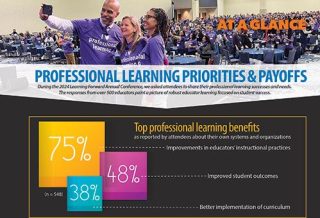FEATURE ARTICLE
Track Data. Tweak Instruction. Repeat.
A constant focus on student progress boosts achievement in Texas district
By Learning Forward
Categories: DataJune 2014
Read the remaining content with membership access. Join or log in below to continue.
Sed ut perspiciatis unde omnis iste natus error sit voluptatem accusantium doloremque laudantium, totam rem aperiam, eaque ipsa quae ab illo inventore veritatis et quasi architecto beatae vitae dicta sunt explicabo. Nemo enim ipsam voluptatem quia voluptas sit aspernatur aut odit aut fugit, sed quia consequuntur magni dolores eos qui ratione voluptatem sequi nesciunt. Neque porro quisquam est, qui dolorem ipsum quia dolor sit amet, consectetur, adipisci velit, sed quia non numquam eius modi tempora incidunt ut labore et dolore magnam aliquam quaerat voluptatem.
This article is excerpted from Reach the Highest Standard in Professional Learning: Data by Tom Guskey, Patricia Roy, Shirley M. Hord, and Valerie von Frank (Corwin Press, 2014). The book is the second in a series exploring Learning Forward’s Standards for Professional Learning. In this volume, the authors help readers understand the crucial function of data for designing, implementing, and evaluating professional learning. Available at www.learningforward.org/bookstore or 800-727-7288.
Aldine ISD Statistics
- Aldine Independent School District is in Harris County, Texas, just north of Houston.
- The district has five high schools, five 9th-grade schools, 10 middle schools, 11 intermediate schools, 33 elementary schools, eight early childhood/pre-K schools, and a pre-kindergarten campus.
- Total enrollment is about 67,500 students, with 86% eligible for free or reduced-price meals.
- A handful of students speak one of five languages other than English, and an additional 31% are Spanish-speaking English language learners.
- Its student population is 2% white, 1% Asian/Pacific Islander, 70% Hispanic, 26% African-American, and 1% other.
Aldine ISD Grades 3-11 Scores

The View From 3 Levels
WANDA BAMBERG, superintendent
“We had to ensure all kids were getting the instruction they were supposed to have as the first step. We said, ‘We’re all going to teach this,’ and outlined strategies. After one year, people saw what a difference it made for kids, and teachers were looking at their own data that showed our kids did so much better that year than they did the prior year. When they realized our kids really could do it, they were willing to do anything. Then we moved on to creating common assessments.”
RAYMOND STUBBLEFIELD, Stephens Elementary School principal
“We’ve always done data analysis in our teams, but now we are really being intentional about drilling down to student work and student thinking and student learning instead of just working on the planning and preparation side. As a campus, we have collective targeted areas. Any decision that we make on our campus is always based on data. It’s always based on student needs that we identify through data analysis.”
BRENNA DORGAN, 4th-grade language arts teacher
“Third- and 4th-grade language arts teachers plan together, and within that team is where we do most of our data analysis. We keep one spreadsheet for each student where we’re trying to see the kid’s progress, benchmarks, report card grades, progress reports, comprehension levels, fluency. We’re trying to make sure it all aligns and that we’re being responsive to the students’ needs when we’re planning together, when we’re planning in our own classrooms, and in the conversations that we’re holding with students. It’s all based on evidence and data. We’re being proactive as well as reactive in our analysis.”
Discussion Questions
The article, “Track data. Tweak instruction. Repeat,” on pp. 44-50 illustrates how the Aldine (Texas) Independent School District uses data to improve teacher practices and raise student achievement. Use these questions to reflect on how your district uses data.
- How do educators in the Aldine district use the data they collect to affect teacher learning in ways that will improve student learning? How does your district use the data it collects?
- What does the case study demonstrate about how data can be used in professional learning at the school level? At the system level?
- What is the district’s role in collecting data? What do you see in the case that is noteworthy about the district’s role? What drawbacks are evident in the district’s data collection? What does your system do at the district level to use data?
- Who should decide how much and what types of data to collect? How did Aldine make those choices? Who currently makes those determinations in your system?
- What additional sources of data would help teachers, school leaders, and district administrators in your system make decisions about professional learning?
- What evidence does Aldine use for how effective professional learning is for teachers? What evidence does your district have for the impact of professional learning?
References
Texas Education Agency. (n.d.). Collaborative monitoring and intervention model — Aldine ISD. Available at www.tea.state.tx.us/Best_Practice_Summaries/Collaborative_Monitoring_and_Intervention_Model–Aldine_ISD.aspx.
Learning Forward is the only professional association devoted exclusively to those who work in educator professional development. We help our members plan, implement, and measure high-quality professional learning so they can achieve success with their systems, schools, and students.
Categories: Data
Recent Issues
LEARNING DESIGNS
February 2025
How we learn influences what we learn. This issue shares essential...
BUILDING BRIDGES
December 2024
Students benefit when educators bridge the continuum of professional...
CURRICULUM-BASED PROFESSIONAL LEARNING
October 2024
High-quality curriculum requires skilled educators to put it into...
LEARNING TO PIVOT
August 2024
Sometimes new information and situations call for major change. This issue...













